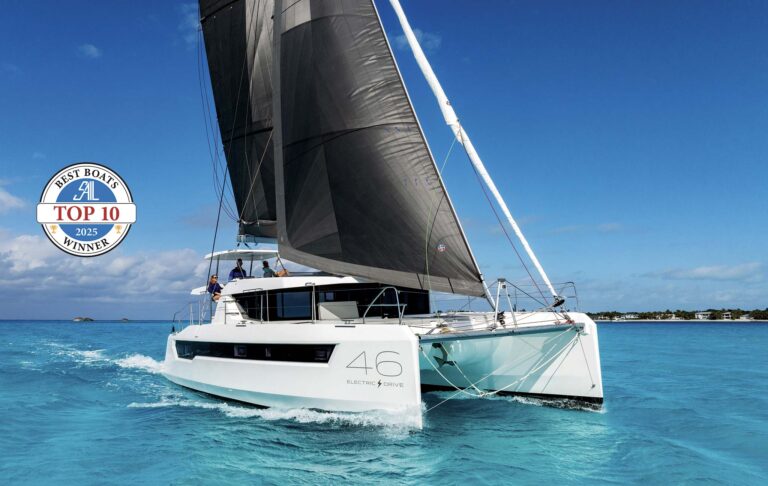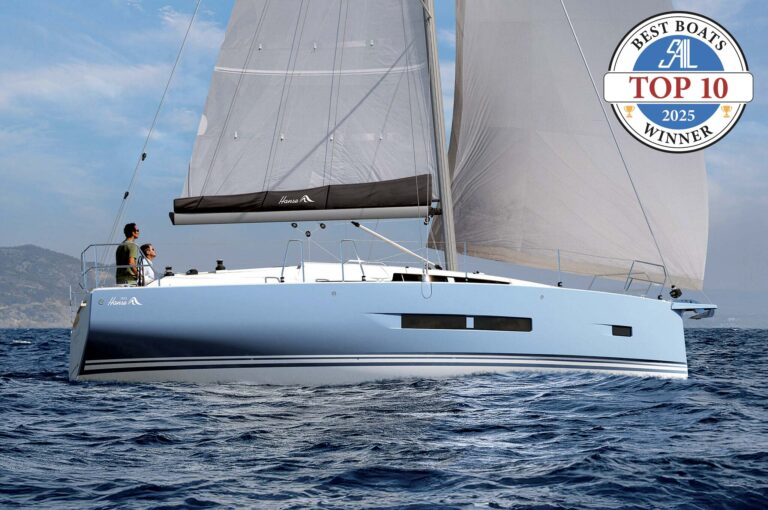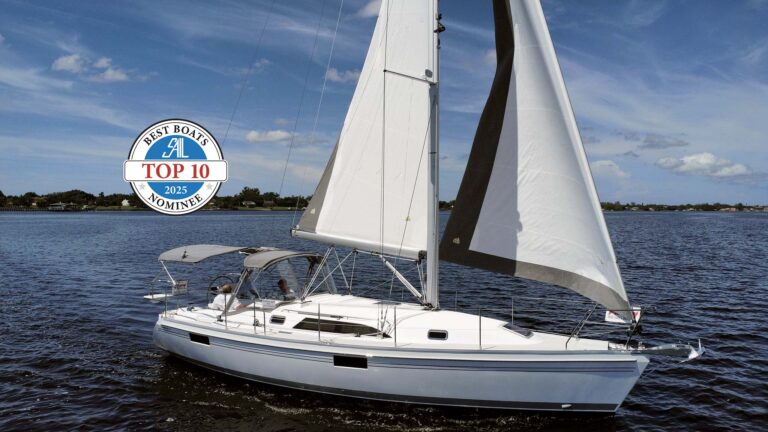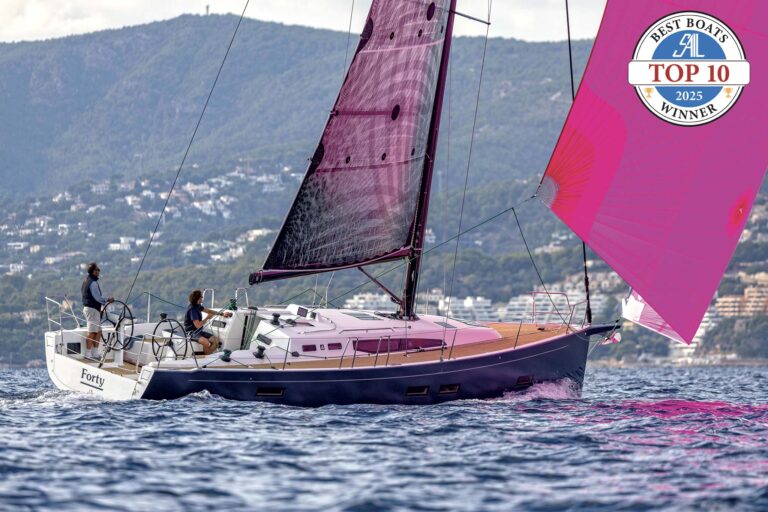
When a fire destroyed the molds for the Telstar trimarans in 1981, Performance Cruising founder and designer Tony Smith rebuilt his factory and started production of the Gemini catamarans. Gemini’s success pushed the Telstars to the back of, but not completely off, the drawing board. After years spent redesigning, re-engineering, and rigorously testing five full-size prototypes, Smith has introduced the new Telstar 28. The trimaran had a lavish launch party at the Performance factory during the Annapolis boat show in 2003, and Smith’s enthusiasm for the design led me to believe he was revolutionizing the trailerable multihull. I jumped aboard on a windy day in Miami to find out for myself.
Under Sail
The Telstar showed off before we even raised the sails. It seemed hemmed in on the dock, but Smith simply retracted the amas to reduce the beam to 8-feet, 6-inches and motored through a narrow opening with 2 feet to spare. Once we were out of the marina and under way, the amas opened easily and the optional 40-horsepower outboard pushed us along at a remarkable 14 knots. The Telstar is stable enough to motor at 10 knots or more with the amas fully retracted.
Out on the bay, it was blowing 18 to 23 knots and gusting to 30. We set the full main, unrolled most of the 150 percent genoa, and the speed shot up into the low teens (our top reaching speed was 15 knots). Tracking was excellent, the helm responded to subtle movements, and acceleration was better than I was expecting. Speed fell off just a bit when we came up onto the wind, but we were still logging double-digit speeds and tacking through 95 to 100 degrees. The leeward ama kicked up some spray, but the cockpit and helm station were relatively dry.
The boat was easily controlled. We never felt overpowered or on the edge. Tacking was straightforward, and there was always enough forward motion to carry us through the eye of the wind. The only minor drawback I could spot was the mainsheet control. The sheet runs to a traveler on the aft beam behind the cockpit, so you have to reach back rather than forward to trim the main.
On Deck
The Telstar is unique in the growing world of folding trimarans in that the main hull has ample side decks and the space between the amas has rigid deck areas. This is possible because of Smith’s ingenious retracting mechanism. The amas slide into the hull, allowing for rigid deck sections without increasing retracted beam. As a result, most of the tri’s 18-foot unretracted beam is relatively easy to walk on while under way.
The cockpit is small by most standards, but is quite adequate for a 28-foot trimaran. There’s room for a helmsman and two crew to work comfortably and plenty of space on the side decks to relax. Antiskid surfaces are placed where you need them, and stainless-steel handholds run the entire length of the coachroof for secure access to the mast or the foredeck.
Belowdecks
Smith has found the delicate balance between accommodation space and headroom—without compromising performance—by flaring the narrow hull dramatically just above the waterline. The Telstar’s center hull provides roughly 6-foot headroom throughout without the appearance of excessive freeboard. Its accommodations are smaller than those of a similar-size monohull, but not by much. The saloon, with two 6-foot-long bench seats and removable table, is comfortable and provides an excellent view out of the fixed coachroof ports. The table drops down to create a double bunk, and two more can be accommodated on a port-side single and a single under the cockpit. The small galley consists of a small sink and a two-burner stove (without adjacent counter space), but the head is proportionally enormous. It runs the full width of the cabin and is equipped with a toilet, sink, and shower, plus stowage space.
Overall, the accommodations plan works well. Fit, finish, and systems installation are up to Gemini standards. Two large forward-opening hatches on the coachroof provide excellent ventilation; the interior is bright thanks to four large fixed ports in the saloon.
Clever Rig
Smith is always looking for new ways to address old problems, and he’s found a way to make the tedious trailerboat task of stepping and unstepping the mast much easier and quicker. There’s no gin pole. No extra rigging. Smith’s patent-pending system utilizes a series of struts that remain attached to the mast and the deck at all times along with two control lines. One person can raise (and lower) the mast and rest it in the proper position for trailering in one fluid motion. The struts act as pivots, so as the mast is raised from the trailering position on the coachroof, the maststep pivots back and then down into the mast boot. Grinding a control line run to a winch in the cockpit is the only effort necessary. Smith reports, “The loads are so small that it takes just two fingers on the winch handle to raise or lower the mast, and it’s in complete control from start to finish.”
Conclusion
The Telstar 28 can sail at 15 knots without scaring the helmsman or the crew. It can go from road-ready on the trailer to ready-to-cruise on the water in 15 minutes. It’s stable and fully maneuverable under power with the amas fully retracted. It’s a 28-foot trailersailer with 6-foot headroom and room for six around the saloon settee. Its rigid side decks create lounging space and provide easy access from the dock. And it’s great fun for a base rice of $62,000. What else could you ask for from a 3,000-pound trailersailer?
Specifications
Price: $62,000 (base, FOB Annapolis, MD) includes sails, deck hardware, (2) winches, transom seat, bottom paint, 2-burner propane stove, 10-hp outboard and transom bracket, ground tackle
Designer and builder: Performance Cruising Inc., Annapolis, MD; tel. 410-626-2720, www.performancecruising.com
Construction: Hull and deck are built of vacuum-infused fiberglass over a closed-cell foam core. Hull-to-deck joint is bonded and bolted. The beams and retracting mechanism are reinforced with unidirectional woven-roving fiberglass and stainless-steel straps. The fixed 2-spreader mast is anodized-aluminum.









